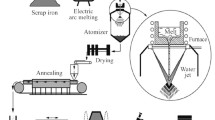Abstract
Trends and prospects for the development of industry according to materials of European and world congresses on powder metallurgy and publications in leading specialized foreign editions are analyzed. Trends of the stable development of the production of powder structural parts for the automotive industry in developed countries, including using assembly technology during joint sintering, are noted. The production of articles using MIM methods is constantly growing, and micro MIM technology has become a separate subindustry, making it possible to manufacture products 0.1 g and less in weight. HIP methods have found a second use; it becomes possible to fabricate large-scale billets from corrosion-resistant steels up to 1000 kg in weight, and post-HIPing technology is used increasingly to improve the quality of products fabricated by additive technologies and important castings. Products up to 100 kg in weight are already being fabricated using additive technologies. The author’s opinion on the developmental prospects of powder metallurgy in Europe and around the world is also formulated, and the developmental directions of industry in Belarus and its influence on the development of global powder metallurgy are determined. In particular, new brands of economically alloyed powder steels are being developed. They make it possible to decrease the prime cost of mass structural parts without worsening their technical characteristics. For the same purpose, the processes of sintering combined with quenching are improved and endogas is used for cooling instead of nitrogen, unlike foreign analogs.




Similar content being viewed by others
REFERENCES
EuroPM2017: Congress & Exhibition, Milan, Italy: ©EPMA, 2017.
Vityaz, P.A., Ilyushchanka, A.Ph., and Savich, V.V., Power metallurgy and metallurgical additive technologies: According to the materials of the Eur. Congr. of Powder Metallurgy Euro PM 2017, Poroshk. Metall., 2017, no. 40, pp. 5–14.
World PM 2016: Current status and future outlook for the global PM industry reviewed in Hamburg, Powder Metall. Rev., 2016, vol. 5, no. 4, pp. 47–51.
Whittaker, David, World PM 2016: Trends in automotive powertrains and their impact on the future of PM applications, Powder Metall. Rev., 2016, vol. 5, no. 4, p. 35–45.
ASM Handbook.Vol. 7.Powder metallurgy. ASM International, 2015.
Marucci, M., Fillari, G., King, P., and Narasimhan, K., A review of current sinter-hardening technology, in PM World Congress,Vienna, Austria, 2004, pp. 36–41.
Sokolowski, P., Lindsley, B., and Hanejko, F., Lean can mean sinter-hard and cost-effective, Met. Powder Rep., 2008, July/Aug, p. 40–48.
Dobrzanski, L., Utilisation of sinter-hardrning treatment for various sintered steels, J. Achiev. Mater. Manuf. Eng., 2007, vol. 24, no. 2, pp. 187–190.
Saccarola, S., Novel high performance, dimensionally controlled PM steels for sinter-hardening, Powder Metall., 2010, vol. 53, no. 3, pp. 184–187.
Engsrom, U., High performance materials for sinter hardening applications, in Proc. PM 2010 World Congr., Florence, Italy, 2010.
Kalss, G., High performance sinterhardened PM steels, in Proc. PM 2010 World Congr., Florence, Italy, 2010.
Duhlstrom, M., High performance PM components heat treated by low pressure carburizing and gas quenching, in Proc. Euro PM 2013 Conf., Sweden, 2013.
Gorokhov, V.M., Guchek, V.N., and Tarusov, I.N., The influence of the method of introducing alloying elements into iron powder on the mechanical properties of sintered low-alloying steel, in Poroshkovaya metallurgiya: inzheneriya poverkhnosti, novye poroshkovye kompozitsionnye materialy. Svarka: Sbornik dokladov 10-go Mezhdunarodnogo simpoziuma. V 2 ch. Ch. 1 (Powder Metallurgy: Surface Engineering, New Powder Composite Materials. Welding: Collected Reports of the 10th Int. Symp. In 2 parts. Part 2), Minsk: Belarus. Navuka, 2017, pp. 68–76.
Introduction to Additive Manufacturing Technology. A Guide for Designers and Engineers. URL: http://www.epma.com/additive-manufacturing.
Ilyushchanka, A.Ph. and Savich, V.V., Powder metallurgy is one of the first additive technologies, in sbornik: Additivnye tekhnologii, materialy i konstruktsii: Materialy nauchno-tekhnicheskoi konferentsii (Collective Articles: Additive Technologies, Materials, and Constructions: Mater. Sci.-Tech. Conf.), Grodno: GrGU, 2016, pp. 20–30.
Bugatti to rial additively manufactured titanium brake calipers, Metal AM, 2018, vol. 25, January. URL: http://www.metal-am.com/bugatti-trial-additivelymanufactured-titanium-brake-calipers/.
Whittaker, David, Combining metal AM and hot isostatic pressing (HIP): Application and process innovations, Met. Add. Manuf., 2017, vol. 3, no. 4, pp. 83–91.
Haan, J., Asseln, M., Zivcec, M., Eschweiler, J., Radermacher, K., and Broeckmann, C., Effect of subsequent hot isostatic pressing on mechanical properties of ASTM F75 alloy produced by selective laser melting, in Euro PM 2014.AM:Characterisation and Post Treatment, 2014.
Roman, O.V., The development of powder metallurgy for 40 years, in 40 Years of Powder Metallurgy in the Republic of Belarus, Minsk: Kovcheg, 2000, pp. 4–29.
Gorokhov, V.M., Doroshkevich, E.A., and Zvonarev, E.V., Theoretical foundations of modeling the elastic-plastic behavior of metal powders when pressed in a rigid matrix, in 50 let poroshkovoi metallurgii Belarusi. Istoriya, dostizheniya, perspektivy (50 Years of Powder Metallurgy of Belarus. History, Achievements, and Prospects), Minsk: GNPO PM, 2010, pp. 151–170.
Vityaz’, P.A., Ilyushchanka, A.Ph., and Savich, V.V., Prospects of powder metallurgy in Belarus, in sbornik nauchnykh statei: Poroshkovaya metallurgiya v Belarusi: vyzovy vremeni (Collected Scientific Articles: Powder Metallurgy in Belarus: Challenges of Time), Minsk: Belarus. Navuka, 2017, pp. 507–526.
Roman, O.V., Skorokhod, V.V., and Fridman, G.V., Ul’trazvuko voi i rezistometricheskii kontrol’ v poroshkovoi metallurgii (Ultrasonic and Resistormetric Control in Powder Metallurgy), Minsk: Vysshaya Shkola, 1989.
Author information
Authors and Affiliations
Corresponding authors
Ethics declarations
The authors declare that they have no conflict of interest.
Additional information
On the 85th Anniversary of the Birthday of Academician V.N. Antsiferov
Translated by N. Korovin
About this article
Cite this article
Vityaz, P.A., Ilyushchanka, A.P. & Savich, V.V. Powder Metallurgy in Belarus and Global Developmental Trends. Russ. J. Non-ferrous Metals 60, 775–781 (2019). https://doi.org/10.3103/S1067821219060191
Received:
Accepted:
Published:
Issue Date:
DOI: https://doi.org/10.3103/S1067821219060191




